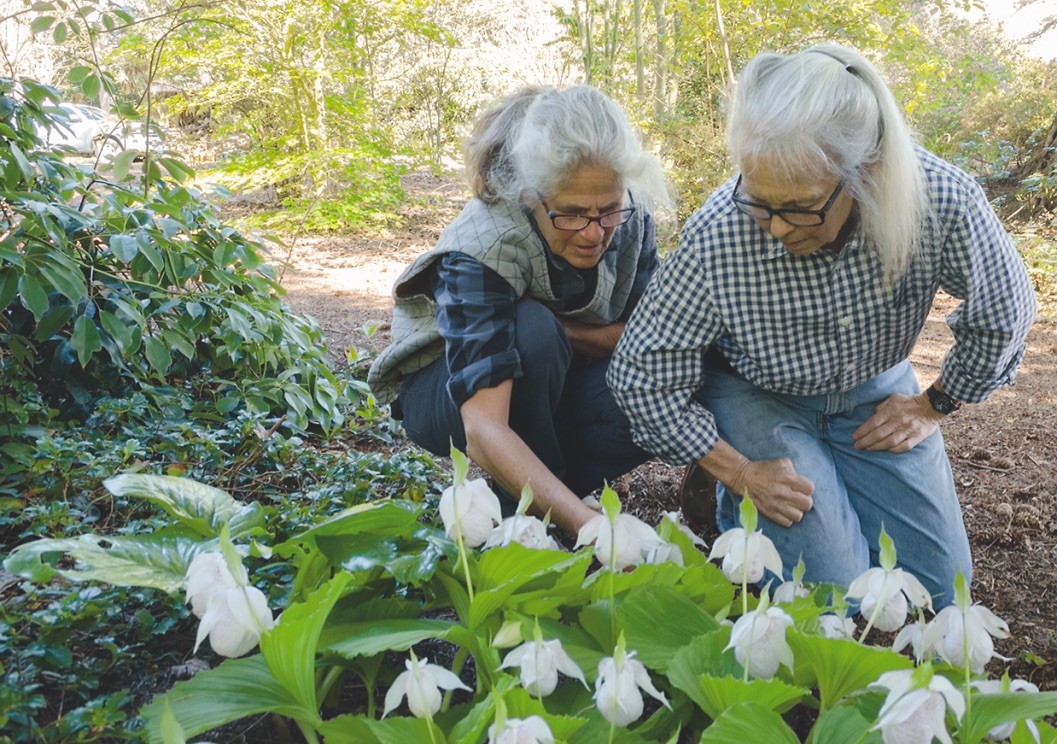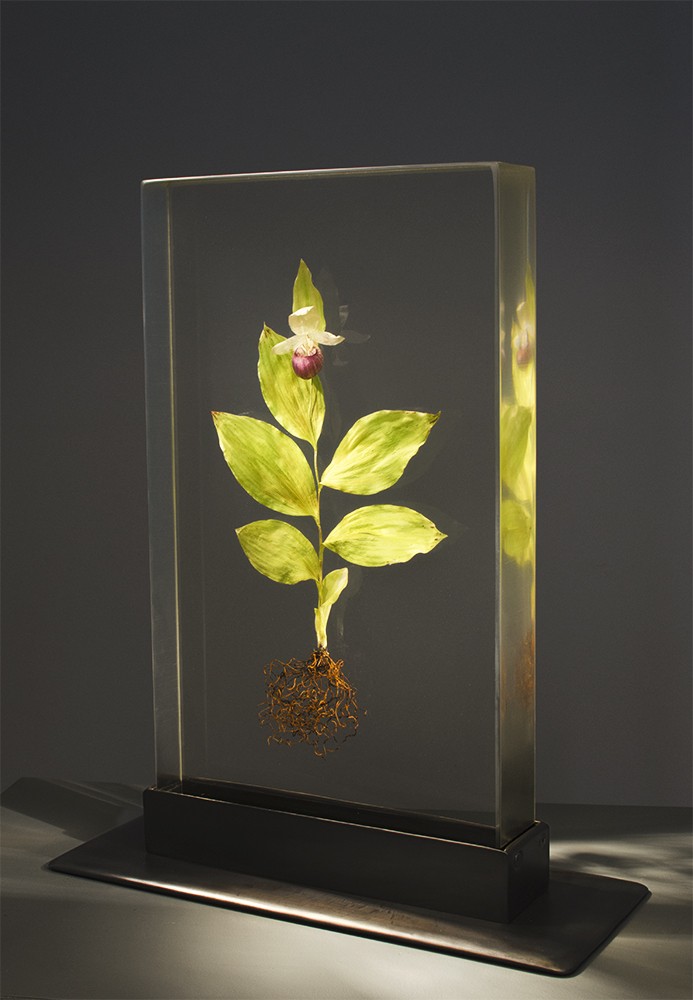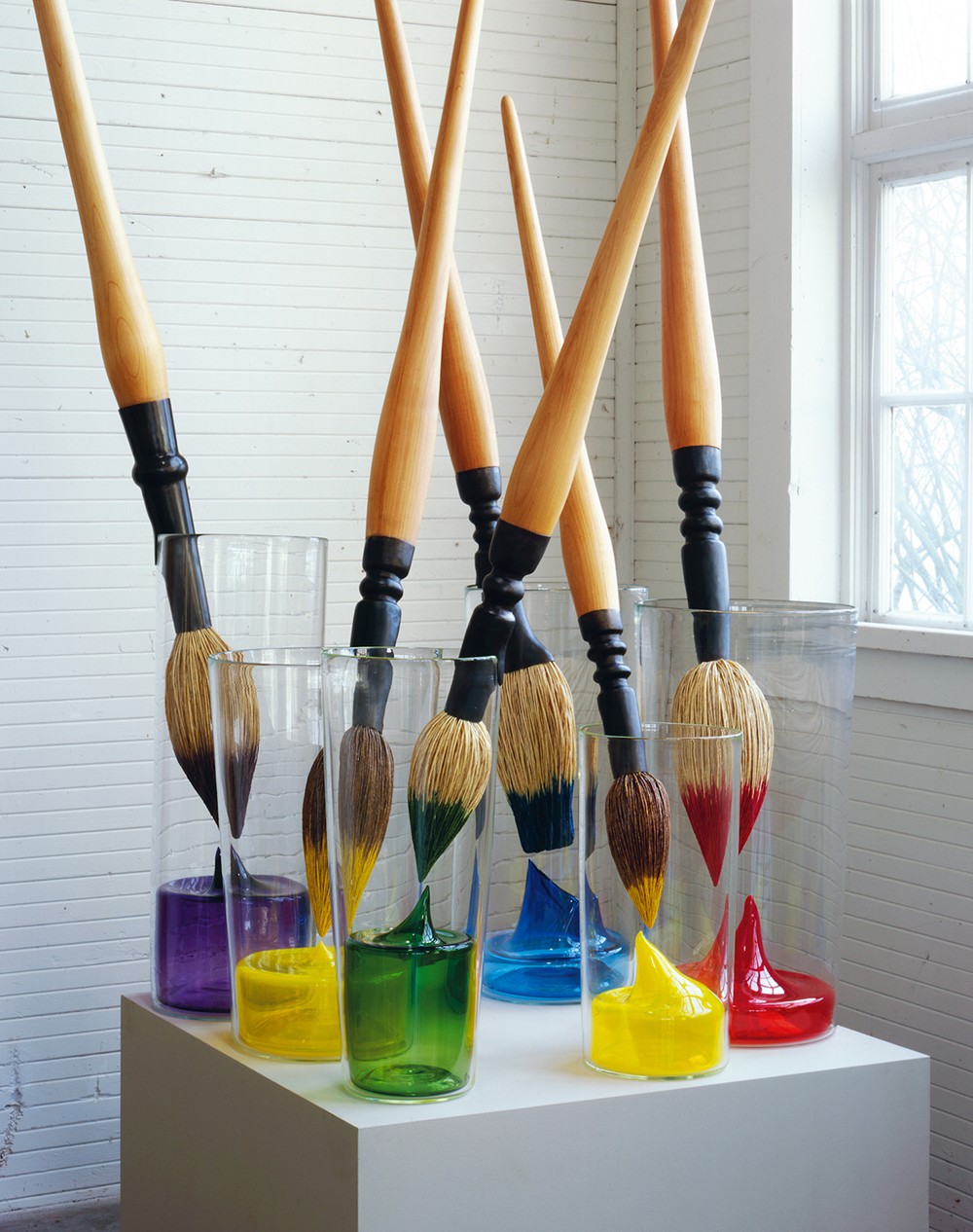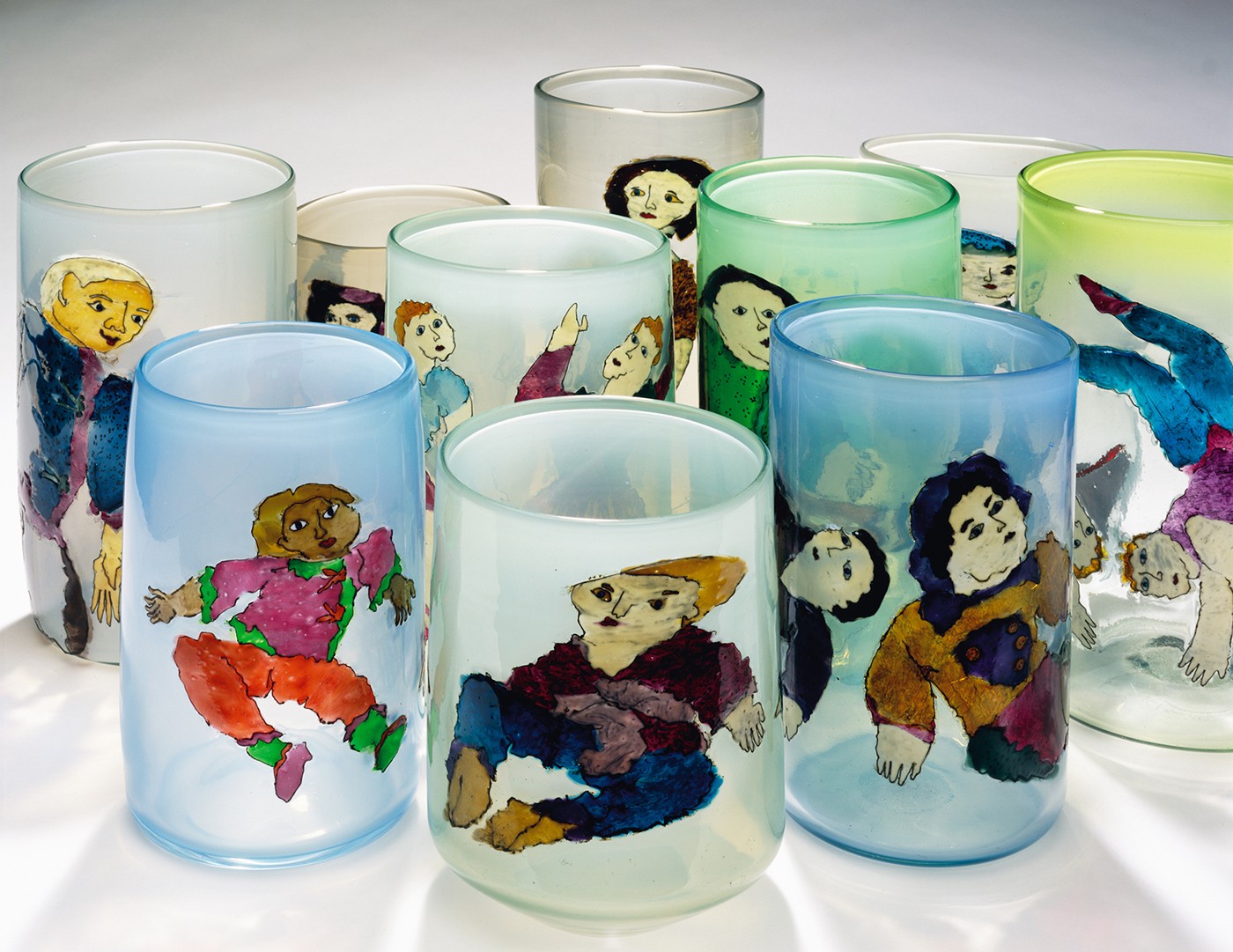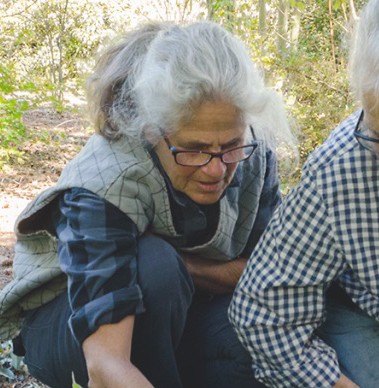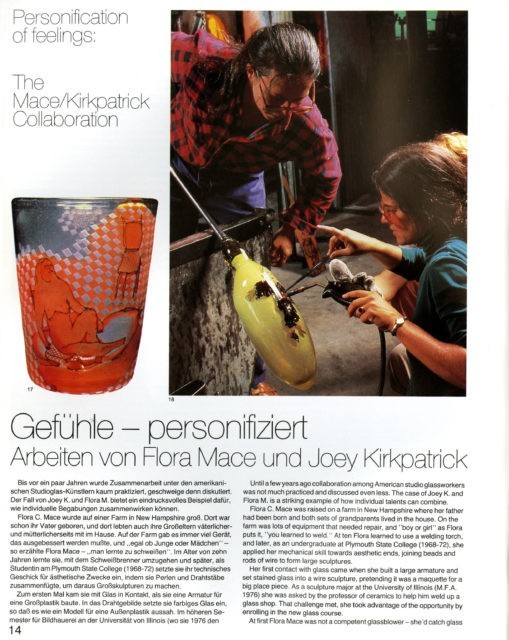In a 1982 interview at Pilchuck, Joey Kirkpatrick speaks with Paul Hollister about her work with Flora Mace, discussing the importance of open forms in their work, glass colors, complexity in the blowing of their pieces, and their wire drawing process. Clip length: 08:41. Interview with Joey Kirkpatrick by Paul Hollister, July 29, 1982. (Rakow title: Joey Kirkpatrick and Flora Mace interview [sound recording] / with Paul M. Hollister, BIB ID: 168477).
Time stamp: 00:00
Clip 1: Joey Kirkpatrick discusses the importance of being able to see through to the other side of her and Flora Mace’s work. Clip length: 02:30.
Joey Kirkpatrick (JK): A lot of times the reason why we use such open forms is cause I want to be able to see through both sides. Like I love how you can look at a piece like this and then see all that on the other side, not even through the glass here, but through it that way.
Paul Hollister (PH): Right, right. And the shapes are getting nice too. The slightly wopsy shape.
JK: Mm-hmm. I think we, I think it was real interesting—
PH: And this one is so much better than that one.
JK: Yeah.
PH: For instance, that’s an earlier one, isn’t it?
JK: Well, it’s that—these are all within the last–some of them even—a couple of them like that doll piece dates to October, actually.
PH: Yeah, I’ve never seen those before.
JK: We just got that one. Actually that one is at the Morris Museum show, I think. I think an interesting thing that happened to us was that when you put the surface decoration on the glass, it creates so much tension on the surface that the form—here, we’re dealing with crystal, right? The Kugler crystal. Here we’re dealing with the glass that’s available in the United States. And what happens is that this surface decoration or what image retains the heat longer than the glass that it’s sitting on does.
PH: [inaudible]
JK: Yeah. And so if I were to take the piece of glass on the pipe and put it in the glory hole and come out and not cool it at all in particular places where the drawings were and just blew, the drawings would pop out like a bubblegum pop.
PH: Mm-hmm.
JK: And so initially when we started doing the process, I think that that seemed, like such a concern to control, to control, to control, because it was so different to see glass not be, you know, tight and right. You know, right on. And so, now that we’ve become more comfortable with the fact that we’re allowing, and we’ve learned how to control—to let the glass take on its own uncharacteristic [inaudible] decoration on top. And that’s—I love these bumpy forms. And I mean I love the sort of—it seems to integrate, you know, the drawings with the glass a lot more, you know, like this one I like.
Time stamp: 02:33
Clip 2: Joey Kirkpatrick talks about her and Flora Mace’s use of color in their work. Clip length: 01:39.
Paul Hollister (PH): It’s a lovely—the plain foggy green, is that iron in the glass, or is that tinted that way? For instance, the one on the end down there.
Joey Kirkpatrick (JK): It’s, it’s—
PH: I think it’s the one on the end down there.
JK: It’s color picked up. It’s a Kugler color, picked up and then it’s gathered over with clear glass.
PH: Mm-hmm.
JK: So all the colors, all the colors on the surface, even if they’re very transparent, are picked up.
PH: Oh, I don’t mean that on the surface. I mean, the tone of the glass itself.
JK: Yeah, that’s what I mean, yeah, I’m sorry, yeah. The body of the glass.
PH: The surface is something you do, you fill that in first, don’t you?
JK: Right. You bend the wires and then they’re filled in with these glass canes by the propane torch. And then—so then they look like this and it’s real interesting because you can’t tell—at this point, you can’t tell the color because the flame has reduced, it’s a reductive atmosphere where the flames [inaudible]. So they appear to be black. These are like a little series of different masks [inaudible].
PH: They look charred almost.
JK: Yeah. And they’re like, they’re very—they’re bright, they’re bright colors, but you won’t know that until the placement, you know, until they get on the glass. You can kind of tell, like here’s a pink and the green and stuff.
Time stamp: 04:07
Clip 3: Joey Kirkpatrick talks about the complexity of blowing her and Flora Mace’s work. Clip length: 03:03.
Joey Kirkpatrick (JK): Uh-huh. Real interesting. One thing that we’ve done with some work—
Paul Hollister (PH): A hell of a job.
JK: Yeah, it would be. Well, what we’ve done with some work lately are especially pieces like this is to give it a feeling of that, that is that we blow the piece and while it’s on the punty we cut the lip to follow the figure. So that there’s a very dramatic point.
PH: Yeah, yeah. Stylized.
JK: Mm-hmm. And it’s a heck of a job because you’ve got to open up the piece. And one thing about trimming is it’s always much easier to trim when your hole is smaller, because you don’t lose control. So what we have to do is totally open the piece up and then bring it out hot enough still to cut like this, and it’s very difficult, but we’ve gotten some pieces. We had a piece like that in New York, a green piece that was cut real dramatically like that. And it was—
PH: I don’t think I saw that. I saw several—
JK: And so—
PH: Well, let’s put it this way. Suppose you made this up like that.
JK: Right.
PH: And then instead of just rolling it, you took this cylinder—
JK: Uh-huh.
PH: —got it the shape you wanted—
JK: Right.
PH: —and put drips of hot glass on the side. And then put those on it.
JK: Right. Uh-huh, right.
PH: Cause it would be suspended like a railroad track on [inaudible]—out in front—and it would be an air space in there.
JK: The—it is a fascinating idea. The thing that I would personally need to figure out is how to make the images expand that way. Cause I would have to be done blowing at that point, you know what I mean?
PH: You wouldn’t know what the diameter—you really wouldn’t know what the diameter was?
JK: No. Well, that I could figure out. But part of it for me, part of the—
PH: If it could be draped over almost like—almost with tongs
JK: Right.
PH: You know, held down with this and this, draped over that.
JK: Definitely I could do it, but then what I’m saying is once it’s on there, what happens when you put these on is they blow out, and they expand and distort, and to me, that’s part of the—
PH: And in this case they wouldn’t do that.
JK: And I don’t think they would. What I would have to do is blow two pieces and then fold them over. And another thing we’ve done is we’ve blown pieces like this, and then put a drawing, let’s say like a drawing and inserted it like this and closed it off at the top so it’s inside there, but never really—I mean we experimented with a lot of different—you know, trying to deal with perception levels.
PH: They’re great. I’d like that one gift-wrapped. [sound of tapping on glass]
JK: Okay. [laughs]
Time stamp: 07:13
Clip 4: Joey Kirpatrick discusses the type of wire she and Flora Mace use for their drawings on glass. Clip length: 01:28.
Paul Hollister (PH): Funny, it looks just like a bunch of soldering, doesn’t it?
Joey Kirkpatrick (JK): Yeah, it really is. And actually how—that’s really one way that Flora pretty much developed this technique; she was a welder before she did this. So it really all is very connected.
PH: What kind of wire is that black wire?
JK: It’s a metal hardware wire, solid metal, very pliable. You can use copper wire. You can’t use galvanized wire.
PH: You can buy that at the hardware store?
JK: Yeah. Although there are moments when right now we’re having a hard time finding it.
PH: It’s so fine.
JK: And it’s a little nerve-wracking. We haven’t been able to find it up here.
PH: Your imagery is ahead of your supply?
JK: Yeah, a little bit, a little bit. [eight second pause, recording stops and starts again]
PH: I think I’d like to start out with greeting cards.
JK: Yeah? [recording stops and starts again]
PH: [PH speaking into recorder] That was Joey Kirkpatrick who works with Flora Mace, and I was talking about their pleasant work that they’re doing.
Permalink